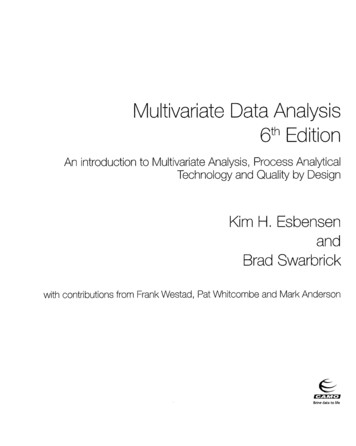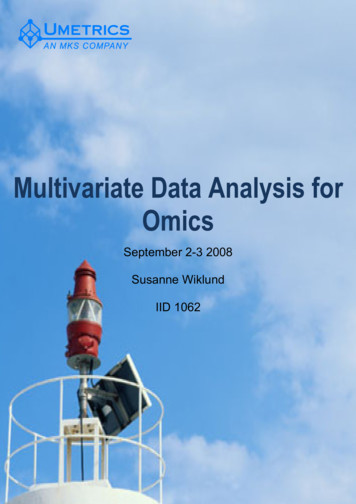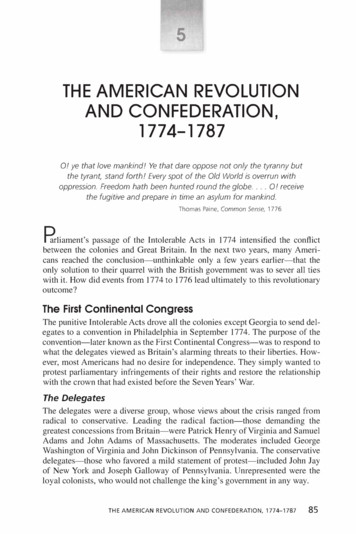Multivariate Statistics Summary And Comparison Of Techniques
Multivariate StatisticsSummary and Comparison of TechniquesP The key to multivariate statistics is understandingconceptually the relationship among techniques withregards to: The kinds of problems each technique is suited for The objective(s) of each technique The data structure required for each technique Sampling considerations for each technique Underlying mathematical model, or lack thereof, ofeach technique Potential for complementary use of techniques1Multivariate TechniquesModely1 y2 . yiTechniquesUnconstrained OrdinationCluster Analysisy1 y2 . yi xMultivariate ANOVAMulti-Response PermutationAnalysis of SimilaritiesMantel TestDiscriminant AnalysisLogistic RegressionClassification TreesIndicator Species Analysisy1 y2 . yi x1 x2 . xj2Constrained OrdinationCanonical CorrelationMultivariate Regression Trees
Multivariate TechniquesTechniqueObjectiveUnconstrained OrdinationExtract gradients of maximum(PCA, MDS, CA, DCA, NMDS) variationCluster Analysis(Family of techinques)Establish groups of similarentitiesDiscriminationTest for & describe differences(MANOVA, MRPP, ANOSIM, among groups of entities orMantel, DA, LR, CART, ISA) predict group membershipConstrained Ordination(RDA, CCA, CAP)Extract gradients of variation independent variables explainableby independent variables3Multivariate TechniquesTechniqueVariance EmphasisUnconstrained OrdinationEmphasizes variation among(PCA, MDS, CA, DCA, NMDS) individual sampling entitiesby defining gradients ofCluster Analysismaximum total sample(Family of techinques)variance; describes the interDiscriminationentity variance structure.(MANOVA, MRPP, ANOSIM,Mantel, DA, LR, CART, ISA)Constrained Ordination(RDA, CCA, CAP)4
Multivariate TechniquesTechniqueVariance EmphasisUnconstrained Ordination(PCA, MDS, CA, DCA, NMDS)Cluster Analysis(Family of techinques)Emphasizes both differencesand similarities amongindividual sampling entitiesDiscriminationby clustering entities based(MANOVA, MRPP, ANOSIM,on inter-entity resemblance.Mantel, DA, LR, CART, ISA)Constrained Ordination(RDA, CCA, CAP)5Multivariate TechniquesTechniqueVariance EmphasisUnconstrained Ordination(PCA, MDS, CA, DCA, NMDS)Cluster Analysis(Family of techinques)DiscriminationEmphasizes variation among(MANOVA, MRPP, ANOSIM, groups of sampling entities;Mantel, DA, LR, CART, ISA)describes the inter-groupvariance structure.Constrained Ordination(RDA, CCA, CAP)6
Multivariate TechniquesTechniqueVariance EmphasisUnconstrained Ordination(PCA, MDS, CA, DCA, NMDS)Cluster Analysis(Family of techinques)Discrimination(MANOVA, MRPP, ANOSIM,Mantel, DA, LR, CART, ISA)Constrained Ordination(RDA, CCA, CAP)Emphasizes variation amongindividual sampling entitiesby defining gradients ofmaximum total samplevariance explainable byenvironmental variables7Multivariate TechniquesTechniqueDependence TypeUnconstrained OrdinationInterdependence(PCA, MDS, CA, DCA, NMDS)Cluster Analysis(Family of (MANOVA, MRPP, ANOSIM,Mantel, DA, LR, CART, ISA)Constrained Ordination(RDA, CCA, CAP)Dependence(& interdependence?)8
Multivariate TechniquesTechniqueData StructureUnconstrained OrdinationOne set; 2 variables (Y)(PCA, MDS, CA, DCA, NMDS)Cluster Analysis(Family of techinques)One set; 2 varibles (Y)Two sets; 1 grouping variableDiscrimination(MANOVA, MRPP, ANOSIM, (X), 2 discriminatingvariables (Y)Mantel, DA, LR, CART, ISA)Constrained Ordination(RDA, CCA, CAP)Two sets; 2 response (Y)variables, 1 explanatory (X)variables9Multivariate 1a12a22a32.an2a13a23a33.an3. a1p. a2p. a3p. . . anpn 1n 2n 3.NCCC.Cc11c21c31.cn1c12c22c32.cn2c13c23c33.cn3. c1p. c2p. c3p. . . cnp10b11b21b31.bn1b12b22b32.bn2b13b23b33.bn3. b1m. b2m. b3m. . . bnmUnconstrained Ordination(PCA, PCO, CA, DCA,NMDS)Cluster Analysis(Family of techinques)
Multivariate 1a12a22a32.an2a13a23a33.an3. a1p. a2p. a3p. . . anpn 1n 2n 3.NCCC.Cc11c21c31.cn1c12c22c32.cn2c13c23c33.cn3. c1p. c2p. c3p. . . cnpb11b21b31.bn1b12b22b32.bn2b13b23b33.bn3. b1m. b2m. b3m. . . bnmDiscrimination Techniques(MANOVA, MRPP,ANOSIM, Mantel; DA,LR, CART, ISA)11Multivariate 1a12a22a32.an2a13a23a33.an3. a1p. a2p. a3p. . . anpn 1n 2n 3.NCCC.Cc11c21c31.cn1c12c22c32.cn2c13c23c33.cn3. c1p. c2p. c3p. . . cnp12b11b21b31.bn1b12b22b32.bn2b13b23b33.bn3. b1m. b2m. b3m. . . bnmConstrained Ordination(RDA, CCA, CAP, COR)MRT
Multivariate TechniquesTechniqueSample CharacteristicsUnconstrained OrdinationN (from one or unknown #(PCA, MDS, CA, DCA, NMDS)pops)Cluster Analysis(Family of techinques)N (from unknown # pop's)DiscriminationN (from known # pop's) or(MANOVA, MRPP, ANOSIM, N1, N2, . (from separateMantel, DA, LR, CART, ISA)pop's)Constrained Ordination(RDA, CCA, CAP)N (from one pop)13Multivariate TechniquesIf the research objective is to:P Describe the major ecological gradients ofvariation among individual samplingentities, and/or to portray samplingentities along "continuous" gradients ofmaximum sample variation, then use.14UnconstrainedOrdination
Multivariate TechniquesIf the research objective is to:P Describe the major ecological gradients ofvariation among individual samplingentities, and/or to portray samplingentities along "continuous" gradients ofUnconstrainedmaximum sample variation, then use.OrdinationP Assume linear relationship toecological gradients.PCA, PCO(MDS)15Multivariate TechniquesIf the research objective is to:P Describe the major ecological gradients ofvariation among individual samplingentities, and/or to portray samplingentities along "continuous" gradients ofUnconstrainedmaximum sample variation, then use.OrdinationP Assume linear relationship toecological gradients.PCA, PCO(MDS)P Assume unimodal relationship toecological gradients.16CA(RA), DCA
Multivariate TechniquesIf the research objective is to:P Describe the major ecological gradients ofvariation among individual samplingentities, and/or to portray samplingentities along "continuous" gradients ofUnconstrainedmaximum sample variation, then use.OrdinationP Assume linear relationship toecological gradients.PCA, PCO(MDS)P Assume unimodal relationship toecological gradients.P Assume no particular relationship;only monotonic relationship betweeninput and output dissimilarities.CA(RA), DCAAlt: PCA*NMDS17Multivariate TechniquesIf the research objective is to:P Establish artificial classes or groups ofsimilar entities where pre-specified, welldefined groups do not already exist,and/or to portray sampling entities in"discrete" groups, then use.18Cluster Analysis
Multivariate TechniquesIf the research objective is to:P Establish artificial classes or groups ofsimilar entities where pre-specified, welldefined groups do not already exist,and/or to portray sampling entities in"discrete" groups, then use.P Assign entities to a specifiednumber of groups to maximizewithin-group similarity or formcomposite clusters.Cluster AnalysisNon-hierarchicalCluster Analysis19Multivariate TechniquesIf the research objective is to:P Establish artificial classes or groups ofsimilar entities where pre-specified, welldefined groups do not already exist,and/or to portray sampling entities in"discrete" groups, then use.P Assign entities to a specifiednumber of groups to maximizewithin-group similarity or formcomposite clusters.P Assign entities to groups anddisplay relationships amonggroups as they form.20Cluster AnalysisNon-hierarchicalCluster AnalysisHierarchicalCluster Analysis
Multivariate TechniquesIf the research objective is to:P Establish artificial classes or groups ofentities with similar species composition andabundance where pre-specified, well-definedgroups do not already exist, based onmeasured environmental variables, and/or toportray sampling entities in "discrete" groupsrepresenting species assemblages withdistinct environmental affinities, then use.ConstrainedCluster Analysis(MRT)21Multivariate TechniquesIf the research objective is to:P Differentiate among pre-specified,well-defined classes or groups ofsampling entities, and to:P Test for “significant” differencesamong groups. Parametric test.22MANOVA / DA
Multivariate TechniquesIf the research objective is to:P Differentiate among pre-specified,well-defined classes or groups ofsampling entities, and to:P Test for “significant” differencesamong groups. Parametric test. Nonparametric tests.MANOVA / DAMRPP,ANOSIM,Mantel23Multivariate TechniquesIf the research objective is to:P Differentiate among pre-specified,well-defined classes or groups ofsampling entities, and to:P Describe the major ecological differences amonggroups. Assume a linear discrimination function.24DA (CAD)
Multivariate TechniquesIf the research objective is to:P Differentiate among pre-specified,well-defined classes or groups ofsampling entities, and to:P Describe the major ecological differences amonggroups. Assume a linear discrimination function. Assume a logistic discrimination function.DA (CAD)LR (MLR)25Multivariate TechniquesIf the research objective is to:P Differentiate among pre-specified,well-defined classes or groups ofsampling entities, and to:P Describe the major ecological differences amonggroups. Assume a linear discrimination function. Assume a logistic discrimination function. Do not assume any particular function.26DA (CAD)LR (MLR)CART (UCT)
Multivariate TechniquesIf the research objective is to:P Differentiate among pre-specified,well-defined classes or groups ofsampling entities, and to:P Describe the major ecological differences amonggroups. Assume a linear discrimination function. Assume a logistic discrimination function. Do not assume any particular function. Identify “indicators” for each group.DA (CAD)LR (MLR)CART (UCT)ISA27Multivariate TechniquesIf the research objective is to:P Differentiate among pre-specified,well-defined classes or groups ofsampling entities, and to:P Predict group membership of futureobservations. Linear classification function.28DA (LDF)
Multivariate TechniquesIf the research objective is to:P Differentiate among pre-specified,well-defined classes or groups ofsampling entities, and to:P Predict group membership of futureobservations. Linear classification function. Logistic classification function.DA (LDF)LR (MLR)29Multivariate TechniquesIf the research objective is to:P Differentiate among pre-specified,well-defined classes or groups ofsampling entities, and to:P Predict group membership of futureobservations. Linear classification function. Logistic classification function. Decision tree classifier.30DA (LDF)LR (MLR)CART (UCT)
Multivariate TechniquesIf the research objective is to:P Differentiate among pre-specified,well-defined classes or groups ofsampling entities, and to:P Predict group membership of futureobservations. Linear classification function. Logistic classification function. Decision tree classifier. Other nonparametric classifiers.DA (LDF)LR (MLR)CART (UCT)KernelK nearest-neighbor31Multivariate TechniquesIf the research objective is to:P Explain the variation in a singlecontinuous dependent variable using twoor more continuous independentvariables, and/or to develop a modelfor predicting the value of thedependent variable from the values ofthe independent variables, then use.MultipleLinearRegressionAlternatives: CART (URT)32
Multivariate TechniquesIf the research objective is to:P Explain the variation in a singledichotomous dependent (grouping) variableusing two or more continuous and/orcategorical independent variables, and/orto develop a model for predicting thegroup membership of a sampling entityfrom the values of the independentvariables, then use.MultipleLogisticRegressionAlternatives: DACART (UCT)33Multivariate TechniquesIf the research objective is to:P Describe the major ecological patternsin one set of (response) variablesexplainable by another set of(explanatory) variables, then use.34ConstrainedOrdination orMRT
Multivariate TechniquesIf the research objective is to:P Describe the major ecological patternsin one set of (response) variablesexplainable by another set of(explanatory) variables, then use.P Assume linear response function ofresponse variables (species) along lineargradients defined by the explanatoryvariables (environment).ConstrainedOrdination orMRTRDA, CAP35Multivariate TechniquesIf the research objective is to:P Describe the major ecological patternsin one set of (response) variablesexplainable by another set of(explanatory) variables, then use.P Assume linear response function ofresponse variables (species) along lineargradients defined by the explanatoryvariables (environment).P Assume unimodal response function ofresponse variables (species) along lineargradients defined by the explanatoryvariables (environment).36ConstrainedOrdination orMRTRDA, CAPCCA, DCCAAlt: RDA*
Multivariate TechniquesIf the research objective is to:P Describe the major ecological patternsin one set of (response) variablesexplainable by another set of(explanatory) variables, then use.P Assume linear response function ofresponse variables (species) along lineargradients defined by the explanatoryvariables (environment).P Assume unimodal response function ofresponse variables (species) along lineargradients defined by the explanatoryvariables (environment).P Do not assume any response function.ConstrainedOrdination orMRTRDA, CAPCCA, DCCAMRT37Multivariate TechniquesIf the research objective is to:P Determine the magnitude of theecological relationships between two setsof variables expressed as distancematrices; i.e., dissimilarities betweensamples, then use.P Determine the magnitude of theecological relationships between two setsof variables expressed as distancematrices after accounting for a third setof variables (i.e., Y X Z), then use.38Mantel TestPartial MantelTest
Dependence TechniquesIndependent Variables39Dependence TechniquesCT Contingency tablesT2-test Hotelling’s T2SLR Simple logistic regressionMANOVA Multivariate analysisof varianceDA Discriminant analysisMLR Multiple logistic regressionSRA Simple linear regressionISA Indicator species analysisMRA Multiple linear regressionRDA Redundancy analysisT-test T-testCCA Can. correspond. analysisANOVA Analysis of varianceCAP Can. prin. coord. analysisUCT Univar. classification treesCOR Canonical corr. analysisURT Univar. regression treesMRT Multivar. regression trees40
Dependence TechniquesIndependent ACAPCCACTMLRUCTCTUCTDASLRDAUCTDADARDA CTRDACAP MRT CAPCCA COR CCAMRASRASRAANOVAANOVAURTRDA Manova RDA Manova RDACAP DACAP MRTCAPCCA ISACCA CORCCACTDAMLRUCTRDACAPCCARDAMRT CAPCOR CCAMRAURTRDACAPCCARDAMRT CAPCOR CCA41Advantages of Multivariate StatisticsP Reflect more accurately the truemultidimensional, multivariatenature of natural systems.P Provide a way to handle large datasets with large numbers ofvariables.P Provide a way of summarizingredundancy in large data sets.P Provide rules for combiningvariables in an "optimal" way.42
Advantages of Multivariate StatisticsP Provide a solution to the multiplecomparison problem by controllingexperimentwise error rate.P Provide a means of detecting andquantifying truly multivariate patternsthat arise out of the correlationalstructure of the variable set.P Provide a means of exploring complexdata sets for patterns and relationshipsfrom which hypotheses can begenerated and subsequently testedexperimentally.43
1 Multivariate Statistics Summary and Comparison of Techniques PThe key to multivariate statistics is understanding conceptually the relationship among techniques with
6.7.1 Multivariate projection 150 6.7.2 Validation scores 150 6.8 Exercise—detecting outliers (Troodos) 152 6.8.1 Purpose 152 6.8.2 Dataset 152 6.8.3 Analysis 153 6.8.4 Summary 156 6.9 Summary:PCAin practice 156 6.10 References 157 7. Multivariate calibration 158 7.1 Multivariate modelling (X, Y): the calibration stage 158 7.2 Multivariate .
An Introduction to Multivariate Design . This simplified example represents a bivariate analysis because the design consists of exactly two dependent or measured variables. The Tricky Definition of the Multivariate Domain Some Alternative Definitions of the Multivariate Domain . “With multivariate statistics, you simultaneously analyze
An Introduction to Multivariate Statistics The term “multivariate statistics” is appropriately used to include all statistics where there are more than two variables simultaneously analyzed. You are already familiar with bivariate statistics such as the Pearson product moment correlation coefficient and the independent groups t-test. A .
Introduction to Multivariate methodsIntroduction to Multivariate methods – Data tables and Notation – What is a projection? – Concept of Latent Variable –“Omics” Introduction to principal component analysis 8/15/2008 3 Background Needs for multivariate data analysis Most data sets today are multivariate – due todue to
Multivariate Statistics 1.1 Introduction 1 1.2 Population Versus Sample 2 1.3 Elementary Tools for Understanding Multivariate Data 3 1.4 Data Reduction, Description, and Estimation 6 1.5 Concepts from Matrix Algebra 7 1.6 Multivariate Normal Distribution 21 1.7 Concluding Remarks 23 1.1 Introduction Data are information.
Multivariate data 1.1 The nature of multivariate data We will attempt to clarify what we mean by multivariate analysis in the next section, however it is worth noting that much of the data examined is observational rather than collected from designed experiments. It is also apparent th
APPLIED MULTIVARIATE STATISTICS FOR THE SOCIAL SCIENCES Now in its 6th edition, the authoritative textbook Applied Multivariate Statistics for the Social Sciences, continues to provide advanced students with a practical and con- ceptual understanding of s
THE AMERICAN REVOLUTION AND CONFEDERATION, 1774-1787 87 . Thomas Paine, a recent English imntigrant to the colonies, argued strongly for what until then had been considered a radical idea. Entitled Common Sense, Paine's essay argued in clear and forceful language for the colonies becoming independent states and breaking all political ties with the British monarchy. Paine argued that it was .























